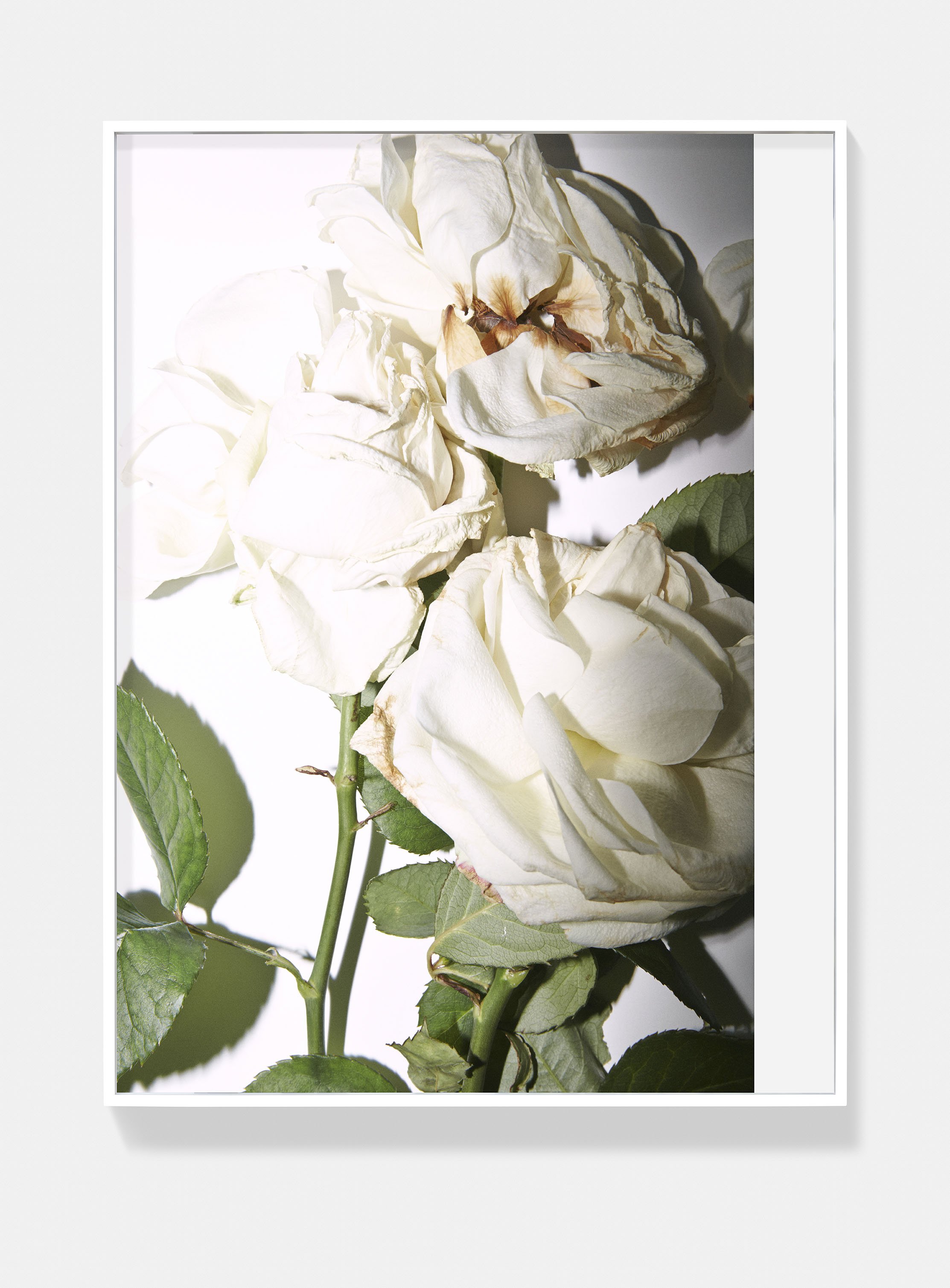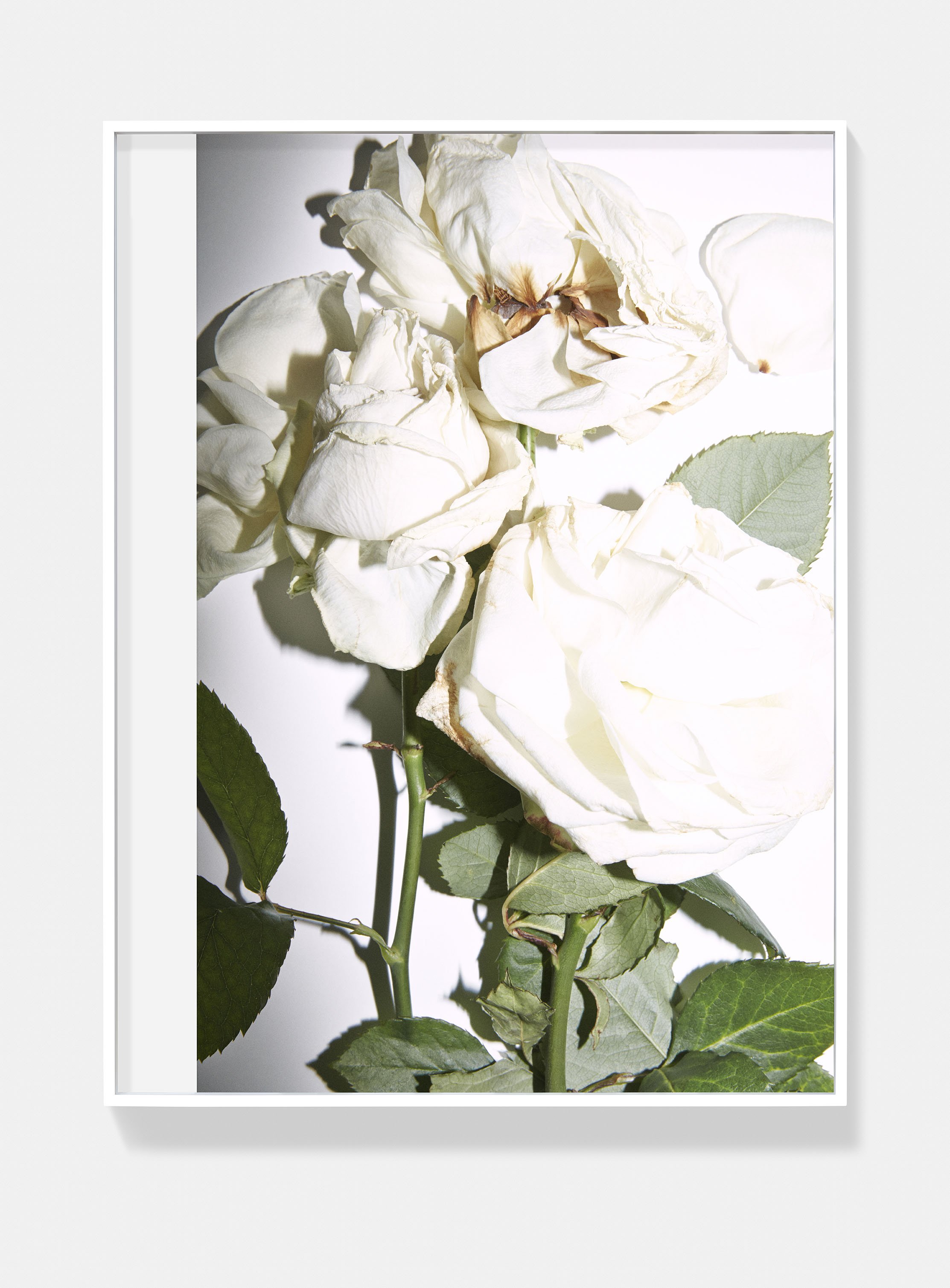Francesca Gavin in conversation with Alessio Bolzoni
To coincide with the creation of our limited edition portfolio of prints, Francesca Gavinspoke to Alessio Bolzoni about his view of beauty, influences and collaborating with the film director Luca Guadagnino.
Alessio Bolzoni’s work questions the limits of the physical body. His photographic work captures figures pushing, pulling, rolling, twisting as if newly formed and just discovering how their frame functions. Whether alone or in constellations, clothed or partially undressed, his work provides a visual metaphor for the internal flux of existence. He is best known for his work in popular culture – notably fashion editorial and campaigns over the past decade for Etudes, Chanel, Louis Vuitton, Dior and Off-White. Another strain of the London-based Italian artist’s work is his stills work for film director Luca Guadagnino, creating imagery for his features Call Me By Your Name and Suspiria. In Bolzoni’s work narrative emerges through angles and movement. Often shooting from below, or at seemingly strange angles, his work feels both accidental and choreographed. His work has been published in three books and exhibited on billboards across Milan. Here he discusses overlaps, identity and the representation of beauty.
How and why did you start working with photography?
My mother’s camera. What can I say more than this? She had this beautiful metallic manual camera with her during some holidays or special occasions. That’s where everything started. My mother’s camera. I still remember the smell. We let Freud take from here.
What interests you about the representation of the human body?
It’s about us – it’s about me I guess. The work in fashion gave me the possibility to explore the representation of the human body a lot – its identity, how to represent women without objectification, and men. I have never considered my subjects for what they were representing in common expectations but what they could create as performers, interacting with my presence, or the presence of others, and my requests. The body represents and defines what we are doing and who we are, in a more global sense: we don’t own the Corpus, like [Jean-Luc] Nancy says, but we are the body. And so I explore that and its expression and its capacity to speak its own language: a step, a contraction, a fall, a different contraction, another step, then another one and another one – the fascinating aspect of moving forward.
What do you find interesting about the points where bodies meet, overlap, appear to lean or press against each other?
I think the contact, the accident and the mistakes have always been the key of my research. I have always collected photography books and images of accidents, people falling, unexpected combinations and also street photography and real people’s personal images from eBay or markets; “scarti”, what people find wrong, waste. I find it interesting what others find wrong. Isn’t a portrait of a person with closed eyes still an expression of that person? A moment of her/his representation?
You’ve worked with billboards. What interests you about scale? How did you start working with that space for Action Reaction?
I have always dreamt of having my images on billboards as if the city was a gallery or a museum and those were the frames. But, of course, it's pretty impossible to organize. Can you imagine how much a space like that can cost? Well, double it! It stayed as a dream project for a long time. After the very first lockdown from March to May 2020 in Milano, where I escaped to from London, I finally went out. The city was frozen into an unusual aesthetic, a time frame where everything was unusual, never seen before. Dust had accumulated on the streets and billboards were empty. I called my friend Teresa Macrì and I told her about the idea and she came with the title and an incredible support. I called the company that owns the best billboards and I presented the project. They supported me in such a generous way. I couldn’t believe the unconditional support they gave me. Here I was, preparing the images for 26 billboards in 16 different locations in Milano, creating a circle of sufferers around the city, a unique performance. No name, title or references would be part of the work. The idea was to let the images speak for themselves with no kind of influence.
Tell me about your Particular Ideas edition and the idea behind it?
I was in Italy one day in 2018, printing the book Abuse II: The Uncanny and as they were cleaning the machines, using discharged paper sheets, I noticed an interesting accidental overlapping of two bodies. I immediately asked the printer to make more versions and I collected these tests. I intended for them to be part of my next work Accumulo (2022). When Particular ideas proposed to me this collaboration I thought of a series of very controlled overlaps. I reproduced two of the original accidental combinations and then selected new unpublished images from that same work and tried the best combinations for this new purpose. I found that the overlaps were pushing extra tension in the work and amplifying the original concept of The Uncanny.
Is your process always instinctive or is there a lot of preparation?
As an artist I believe in the importance of improvisation and also in the observation of reality. But preparation, intentions, projecting and planning are everything to make sure all the elements are at my disposal to create what I need.
What are some of your current influences and inspirations?
I just read Frankenstein by Mary Shelley again. I had to read it twice in a row, because when I finished the first time I didn’t want to get out of it too soon. It’s an incredible masterpiece, of course. She observes nature and the way men think they can perverse it and manipulate it, but the result is what she calls it, a wreck, a monster. What a beautiful work and never been so important and modern I think.
What interests you about collaboration? I’m thinking your work with the film director Luca Guadagnino, for example.
I love collaborating in general, whether it's with an art director or a client, another artist as Luca or a curator. I love engaging in conversations, exploring ideas and sharing views. I normally work by myself so when I have a chance to collaborate I jump on it and try to get the best I can. I think the balance of solo work and collective work is something I try to keep part of my experience.
What do you find interesting about creating stills of filmic work. Are you interested in playing with the structure of film itself in some way?
I found it interesting because it’s for Luca first of all. Whenever he asks for my interpretation of his work it’s just an incredible honour and a beautiful challenge. Luca is first of all a great collaborator and supporter. When he asks me to work on something he asks for my point of view, giving me the freedom of working and expressing myself. He shares the script, he tells me the story he wants to express, I go see him working on set, I get the feeling of the story. He empowers me with his unconditional support with no control of the work I create.
Would you agree that there is something balletic or dance-like about the poses and positions you capture? Is that sense of choreography something you are interested in?
What I explore is movement and body expression. It’s not an actual dance. It’s more a controlled movement that maybe brings us more to the idea of a performance. Maybe I should acknowledge here that Pina Bausch, Simone Forti, Yvonne Rainer and Sasha Waltz are some of the women performers and choreographers I admire the most. But also Vito Acconci, Bruce Nauman and many other body artists and performers have influenced my work.
What do you think is interesting about working in a fashion context? Although clearly this is just one aspect of your practice.
It’s so much fun! I love collaborating and this is an important aspect of fashion and commercial work. You’re part of a group of work. Even if my vision is key to the final result, it’s all made through a collaboration with many people. I like the rapidity, the challenges and the rhythm of the system which most of all it’s made by some of the most beautiful, interesting and smart people I know.
What is your idea of beauty?
I think this was my exact question when I started doing the first work, all the time. I was driven to look for a way to erase the sexualisation and the objectification of my subjects, especially of women. Looking for something that would have given a general sense of empowerment through their representation. I honestly think that a lot has been done in the last 15 years and more needs to be explored with intelligence and sensitivity. But I do believe that the changes that last are sometimes the slowest.
See Alessio Bolzoni’s edition for Particular Ideas here and find more from Francesca Gavin at www.francescagavin.com and @roughversion.
All images by Alessio Bolzoni, courtesy the artist.






